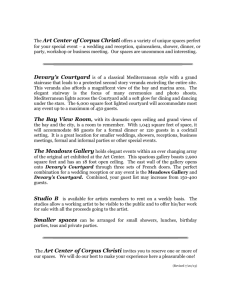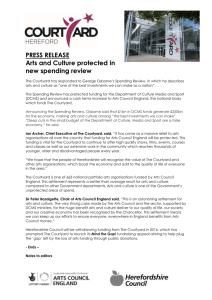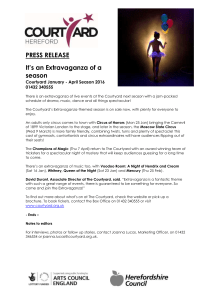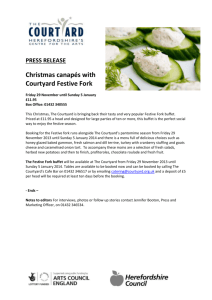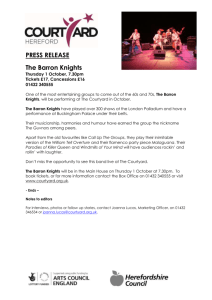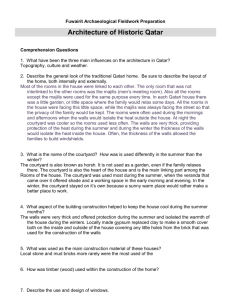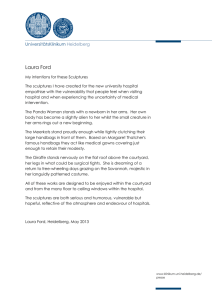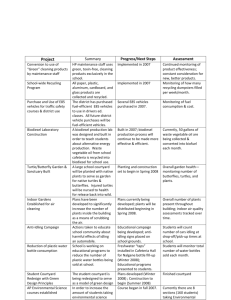DATE - National Portrait Gallery
advertisement
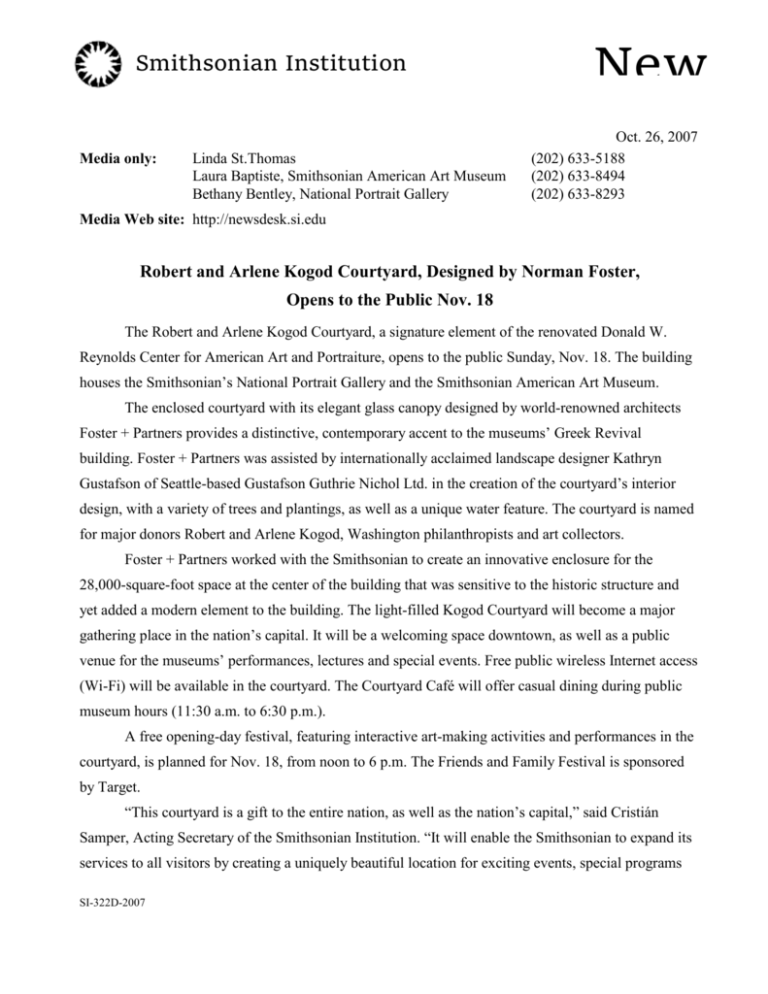
Smithsonian Institution Media only: Linda St.Thomas Laura Baptiste, Smithsonian American Art Museum Bethany Bentley, National Portrait Gallery New s Oct. 26, 2007 (202) 633-5188 (202) 633-8494 (202) 633-8293 Media Web site: http://newsdesk.si.edu Robert and Arlene Kogod Courtyard, Designed by Norman Foster, Opens to the Public Nov. 18 The Robert and Arlene Kogod Courtyard, a signature element of the renovated Donald W. Reynolds Center for American Art and Portraiture, opens to the public Sunday, Nov. 18. The building houses the Smithsonian’s National Portrait Gallery and the Smithsonian American Art Museum. The enclosed courtyard with its elegant glass canopy designed by world-renowned architects Foster + Partners provides a distinctive, contemporary accent to the museums’ Greek Revival building. Foster + Partners was assisted by internationally acclaimed landscape designer Kathryn Gustafson of Seattle-based Gustafson Guthrie Nichol Ltd. in the creation of the courtyard’s interior design, with a variety of trees and plantings, as well as a unique water feature. The courtyard is named for major donors Robert and Arlene Kogod, Washington philanthropists and art collectors. Foster + Partners worked with the Smithsonian to create an innovative enclosure for the 28,000-square-foot space at the center of the building that was sensitive to the historic structure and yet added a modern element to the building. The light-filled Kogod Courtyard will become a major gathering place in the nation’s capital. It will be a welcoming space downtown, as well as a public venue for the museums’ performances, lectures and special events. Free public wireless Internet access (Wi-Fi) will be available in the courtyard. The Courtyard Café will offer casual dining during public museum hours (11:30 a.m. to 6:30 p.m.). A free opening-day festival, featuring interactive art-making activities and performances in the courtyard, is planned for Nov. 18, from noon to 6 p.m. The Friends and Family Festival is sponsored by Target. “This courtyard is a gift to the entire nation, as well as the nation’s capital,” said Cristián Samper, Acting Secretary of the Smithsonian Institution. “It will enable the Smithsonian to expand its services to all visitors by creating a uniquely beautiful location for exciting events, special programs SI-322D-2007 and quiet contemplation. We could not be more grateful to the Kogods for their generosity and vision that made this beautiful courtyard possible.” “It has been a privilege to work on a project with such cultural importance and historical sensitivity to Washington,” said Norman Foster of Foster + Partners. “The design for the Robert and Arlene Kogod Courtyard is driven by a deep respect for the Old Patent Office Building, reinforcing the character of the existing building without competing with it. Floating above the courtyard, the canopy catches the light, creating a new heart at the center of this landmark in the nation’s capital.” “The landscape design of the courtyard celebrates the past and the future of this extraordinary building,” said Gustafson. “The water scrim, which traverses the length of the courtyard, reflects the historic fabric of the walls and the glass canopy above. It will fill the space with movement.” The interior landscape also features two 32-foot high ficus trees, 16 black olive trees and a variety of shrubs and ferns. In 2004, following an international competition, the Smithsonian announced that a panel of jurors had selected the designs of London-based architects Foster + Partners. Foster + Partners has designed numerous innovative and award-winning projects, such as the Great Court at the British Museum in London and the Reichstag, the New German Parliament in Berlin. The firm’s most recent project in the United States is the Hearst Tower in New York City. The roof is a wavy glass-and-steel structure that appears to float over the courtyard, letting in natural light but protecting visitors from the elements. The double-glazed glass panels are set in a grid completely supported by eight aluminum-clad columns located around the perimeter of the courtyard so that the weight of the roof does not affect the National Historic Landmark building. The courtyard, which can be viewed from the museums’ galleries, will accommodate an array of activities, including art-making programs, children’s activities, concerts and performances. Funding The total cost of renovation for the Donald W. Reynolds Center is $283 million. Federal funds—$166 million—paid for the infrastructure work and historic preservation of the building. Private support totaled $117 million, which includes $63 million for the courtyard enclosure and its interior design ($25 million from Robert and Arlene Kogod and $38 million from private donors). Renovation of the Building The Smithsonian began an extensive renovation of the museums’ building in 2001, following the replacement of the roof in 1999. The renovation of the structure, known to historians as the Patent SI-322D-2007 2 Office Building, included replacing all key mechanical systems (heating, ventilation, air conditioning); replacing more than 550 windows with an ultraviolet light filter to protect artworks from damaging sunlight and a hand-blown exterior layer that looks like historic glass; restoring original marble floor pavers and matching others with historically accurate reproductions; installing new fire and security systems; and replacing elevators and electrical systems throughout the entire building. The scope of the renovation project expanded dramatically in 2002, when the Smithsonian began to consider enclosing the outdoor courtyard. From 1968, when the Smithsonian opened its two museums in the National Historic Landmark building, until it closed for renovations in 2000, the courtyard was a grassy outdoor space with paths leading into the museums, trees, and tables and chairs, where visitors relaxed and enjoyed the quiet of a city space enclosed on all four sides. Now, with the glass canopy allowing natural light, the courtyard can be used year-round in all kinds of weather, enabling the public more opportunities to visit and enjoy the space. The courtyard landscaping enhances the outdoor feeling with mature trees, plantings and a water feature along the floor. The courtyard is essentially an elaborate rooftop garden; below it is the Nan Tucker McEvoy Auditorium. Plans for enclosing the courtyard began in 2002, and the following year, the Institution received approval from Congress (August 2003) for the privately funded enhancement of the building. Proposals were sought for a design that would not affect the structure or integrity of the National Historic Landmark building. Foster + Partners was selected, and approvals from the National Capital Planning Commission and the Commission of Fine Arts were obtained. History of Building Praised by Walt Whitman as the “noblest of Washington buildings,” the historic Patent Office Building is one of the finest examples of Greek Revival architecture in the United States. Built in phases between 1836 and 1868, the building was constructed to serve as the U.S. Patent Office and other government offices throughout the 19th century. Among the largest of the early federal buildings, it manifested the importance of the Patent Office (1840 to 1932) during an era when technological invention drove the national economy and began to mold American character. More than one-half million patents were issued, and the building was designed to house both the patent examiners and the models required with the inventors’ applications. The building became a tourist attraction with the Declaration of Independence on display, art collections from the National Institute and sometimes historical artifacts. The building also served as a SI-322D-2007 3 temporary barracks and hospital during the Civil War and was the site of President Lincoln’s inaugural ball in 1865. The Patent Office moved out of the building in 1932 and the Civil Service Commission moved into the offices. By the 1950s, the building was scheduled for demolition, but historic preservationists campaigned to save it, and in 1955 President Eisenhower ordered that it be preserved. Congress transferred the building to the Smithsonian in 1958 to house art collections and, in 1965, the building was designated a National Historic Landmark. The Smithsonian American Art Museum and the National Portrait Gallery have shared the building since 1968. The recent renovation and refurbishment of the building’s historic features was completed in 2006. The Smithsonian American Art Museum and the National Portrait Gallery are collectively known as the Donald W. Reynolds Center for American Art and Portraiture in recognition of the generous donation of the Donald W. Reynolds Foundation. ### Note to editors: High-resolution images of the building are available at http://newsdesk.si.edu/photos. Additional information about the project is available at http://newsdesk.si.edu. SI-322D-2007 4

